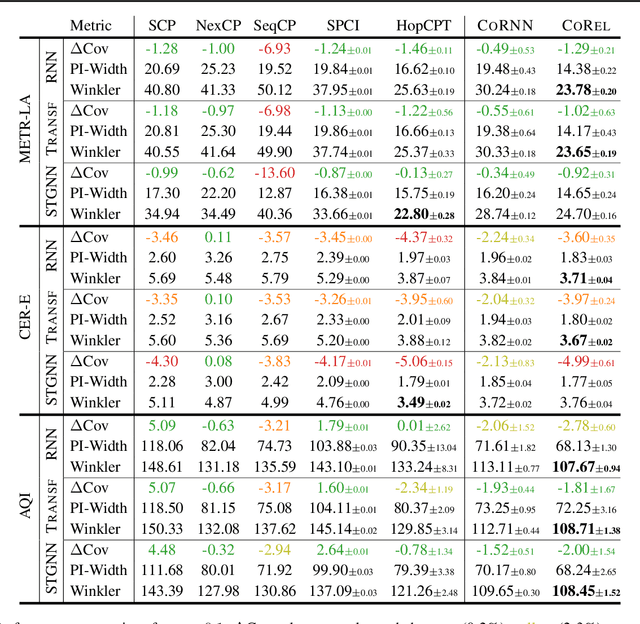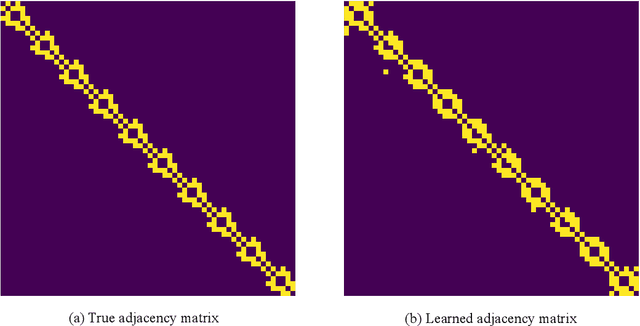Cesare Alippi
Hierarchical Message-Passing Policies for Multi-Agent Reinforcement Learning
Jul 31, 2025Abstract:Decentralized Multi-Agent Reinforcement Learning (MARL) methods allow for learning scalable multi-agent policies, but suffer from partial observability and induced non-stationarity. These challenges can be addressed by introducing mechanisms that facilitate coordination and high-level planning. Specifically, coordination and temporal abstraction can be achieved through communication (e.g., message passing) and Hierarchical Reinforcement Learning (HRL) approaches to decision-making. However, optimization issues limit the applicability of hierarchical policies to multi-agent systems. As such, the combination of these approaches has not been fully explored. To fill this void, we propose a novel and effective methodology for learning multi-agent hierarchies of message-passing policies. We adopt the feudal HRL framework and rely on a hierarchical graph structure for planning and coordination among agents. Agents at lower levels in the hierarchy receive goals from the upper levels and exchange messages with neighboring agents at the same level. To learn hierarchical multi-agent policies, we design a novel reward-assignment method based on training the lower-level policies to maximize the advantage function associated with the upper levels. Results on relevant benchmarks show that our method performs favorably compared to the state of the art.
Over-squashing in Spatiotemporal Graph Neural Networks
Jun 18, 2025Abstract:Graph Neural Networks (GNNs) have achieved remarkable success across various domains. However, recent theoretical advances have identified fundamental limitations in their information propagation capabilities, such as over-squashing, where distant nodes fail to effectively exchange information. While extensively studied in static contexts, this issue remains unexplored in Spatiotemporal GNNs (STGNNs), which process sequences associated with graph nodes. Nonetheless, the temporal dimension amplifies this challenge by increasing the information that must be propagated. In this work, we formalize the spatiotemporal over-squashing problem and demonstrate its distinct characteristics compared to the static case. Our analysis reveals that counterintuitively, convolutional STGNNs favor information propagation from points temporally distant rather than close in time. Moreover, we prove that architectures that follow either time-and-space or time-then-space processing paradigms are equally affected by this phenomenon, providing theoretical justification for computationally efficient implementations. We validate our findings on synthetic and real-world datasets, providing deeper insights into their operational dynamics and principled guidance for more effective designs.
PeakWeather: MeteoSwiss Weather Station Measurements for Spatiotemporal Deep Learning
Jun 16, 2025Abstract:Accurate weather forecasts are essential for supporting a wide range of activities and decision-making processes, as well as mitigating the impacts of adverse weather events. While traditional numerical weather prediction (NWP) remains the cornerstone of operational forecasting, machine learning is emerging as a powerful alternative for fast, flexible, and scalable predictions. We introduce PeakWeather, a high-quality dataset of surface weather observations collected every 10 minutes over more than 8 years from the ground stations of the Federal Office of Meteorology and Climatology MeteoSwiss's measurement network. The dataset includes a diverse set of meteorological variables from 302 station locations distributed across Switzerland's complex topography and is complemented with topographical indices derived from digital height models for context. Ensemble forecasts from the currently operational high-resolution NWP model are provided as a baseline forecast against which to evaluate new approaches. The dataset's richness supports a broad spectrum of spatiotemporal tasks, including time series forecasting at various scales, graph structure learning, imputation, and virtual sensing. As such, PeakWeather serves as a real-world benchmark to advance both foundational machine learning research, meteorology, and sensor-based applications.
Malware families discovery via Open-Set Recognition on Android manifest permissions
May 19, 2025Abstract:Malware are malicious programs that are grouped into families based on their penetration technique, source code, and other characteristics. Classifying malware programs into their respective families is essential for building effective defenses against cyber threats. Machine learning models have a huge potential in malware detection on mobile devices, as malware families can be recognized by classifying permission data extracted from Android manifest files. Still, the malware classification task is challenging due to the high-dimensional nature of permission data and the limited availability of training samples. In particular, the steady emergence of new malware families makes it impossible to acquire a comprehensive training set covering all the malware classes. In this work, we present a malware classification system that, on top of classifying known malware, detects new ones. In particular, we combine an open-set recognition technique developed within the computer vision community, namely MaxLogit, with a tree-based Gradient Boosting classifier, which is particularly effective in classifying high-dimensional data. Our solution turns out to be very practical, as it can be seamlessly employed in a standard classification workflow, and efficient, as it adds minimal computational overhead. Experiments on public and proprietary datasets demonstrate the potential of our solution, which has been deployed in a business environment.
Preference Isolation Forest for Structure-based Anomaly Detection
May 16, 2025Abstract:We address the problem of detecting anomalies as samples that do not conform to structured patterns represented by low-dimensional manifolds. To this end, we conceive a general anomaly detection framework called Preference Isolation Forest (PIF), that combines the benefits of adaptive isolation-based methods with the flexibility of preference embedding. The key intuition is to embed the data into a high-dimensional preference space by fitting low-dimensional manifolds, and to identify anomalies as isolated points. We propose three isolation approaches to identify anomalies: $i$) Voronoi-iForest, the most general solution, $ii$) RuzHash-iForest, that avoids explicit computation of distances via Local Sensitive Hashing, and $iii$) Sliding-PIF, that leverages a locality prior to improve efficiency and effectiveness.
Hashing for Structure-based Anomaly Detection
May 16, 2025Abstract:We focus on the problem of identifying samples in a set that do not conform to structured patterns represented by low-dimensional manifolds. An effective way to solve this problem is to embed data in a high dimensional space, called Preference Space, where anomalies can be identified as the most isolated points. In this work, we employ Locality Sensitive Hashing to avoid explicit computation of distances in high dimensions and thus improve Anomaly Detection efficiency. Specifically, we present an isolation-based anomaly detection technique designed to work in the Preference Space which achieves state-of-the-art performance at a lower computational cost. Code is publicly available at https://github.com/ineveLoppiliF/Hashing-for-Structure-based-Anomaly-Detection.
PIF: Anomaly detection via preference embedding
May 15, 2025Abstract:We address the problem of detecting anomalies with respect to structured patterns. To this end, we conceive a novel anomaly detection method called PIF, that combines the advantages of adaptive isolation methods with the flexibility of preference embedding. Specifically, we propose to embed the data in a high dimensional space where an efficient tree-based method, PI-Forest, is employed to compute an anomaly score. Experiments on synthetic and real datasets demonstrate that PIF favorably compares with state-of-the-art anomaly detection techniques, and confirm that PI-Forest is better at measuring arbitrary distances and isolate points in the preference space.
FX-DARTS: Designing Topology-unconstrained Architectures with Differentiable Architecture Search and Entropy-based Super-network Shrinking
Apr 25, 2025Abstract:Strong priors are imposed on the search space of Differentiable Architecture Search (DARTS), such that cells of the same type share the same topological structure and each intermediate node retains two operators from distinct nodes. While these priors reduce optimization difficulties and improve the applicability of searched architectures, they hinder the subsequent development of automated machine learning (Auto-ML) and prevent the optimization algorithm from exploring more powerful neural networks through improved architectural flexibility. This paper aims to reduce these prior constraints by eliminating restrictions on cell topology and modifying the discretization mechanism for super-networks. Specifically, the Flexible DARTS (FX-DARTS) method, which leverages an Entropy-based Super-Network Shrinking (ESS) framework, is presented to address the challenges arising from the elimination of prior constraints. Notably, FX-DARTS enables the derivation of neural architectures without strict prior rules while maintaining the stability in the enlarged search space. Experimental results on image classification benchmarks demonstrate that FX-DARTS is capable of exploring a set of neural architectures with competitive trade-offs between performance and computational complexity within a single search procedure.
DRAN: A Distribution and Relation Adaptive Network for Spatio-temporal Forecasting
Apr 02, 2025



Abstract:Accurate predictions of spatio-temporal systems' states are crucial for tasks such as system management, control, and crisis prevention. However, the inherent time variance of spatio-temporal systems poses challenges to achieving accurate predictions whenever stationarity is not granted. To address non-stationarity frameworks, we propose a Distribution and Relation Adaptive Network (DRAN) capable of dynamically adapting to relation and distribution changes over time. While temporal normalization and de-normalization are frequently used techniques to adapt to distribution shifts, this operation is not suitable for the spatio-temporal context as temporal normalization scales the time series of nodes and possibly disrupts the spatial relations among nodes. In order to address this problem, we develop a Spatial Factor Learner (SFL) module that enables the normalization and de-normalization process in spatio-temporal systems. To adapt to dynamic changes in spatial relationships among sensors, we propose a Dynamic-Static Fusion Learner (DSFL) module that effectively integrates features learned from both dynamic and static relations through an adaptive fusion ratio mechanism. Furthermore, we introduce a Stochastic Learner to capture the noisy components of spatio-temporal representations. Our approach outperforms state of the art methods in weather prediction and traffic flows forecasting tasks. Experimental results show that our SFL efficiently preserves spatial relationships across various temporal normalization operations. Visualizations of the learned dynamic and static relations demonstrate that DSFL can capture both local and distant relationships between nodes. Moreover, ablation studies confirm the effectiveness of each component.
Relational Conformal Prediction for Correlated Time Series
Feb 13, 2025



Abstract:We address the problem of uncertainty quantification in time series forecasting by exploiting observations at correlated sequences. Relational deep learning methods leveraging graph representations are among the most effective tools for obtaining point estimates from spatiotemporal data and correlated time series. However, the problem of exploiting relational structures to estimate the uncertainty of such predictions has been largely overlooked in the same context. To this end, we propose a novel distribution-free approach based on the conformal prediction framework and quantile regression. Despite the recent applications of conformal prediction to sequential data, existing methods operate independently on each target time series and do not account for relationships among them when constructing the prediction interval. We fill this void by introducing a novel conformal prediction method based on graph deep learning operators. Our method, named Conformal Relational Prediction (CoRel), does not require the relational structure (graph) to be known as a prior and can be applied on top of any pre-trained time series predictor. Additionally, CoRel includes an adaptive component to handle non-exchangeable data and changes in the input time series. Our approach provides accurate coverage and archives state-of-the-art uncertainty quantification in relevant benchmarks.
 Add to Chrome
Add to Chrome Add to Firefox
Add to Firefox Add to Edge
Add to Edge